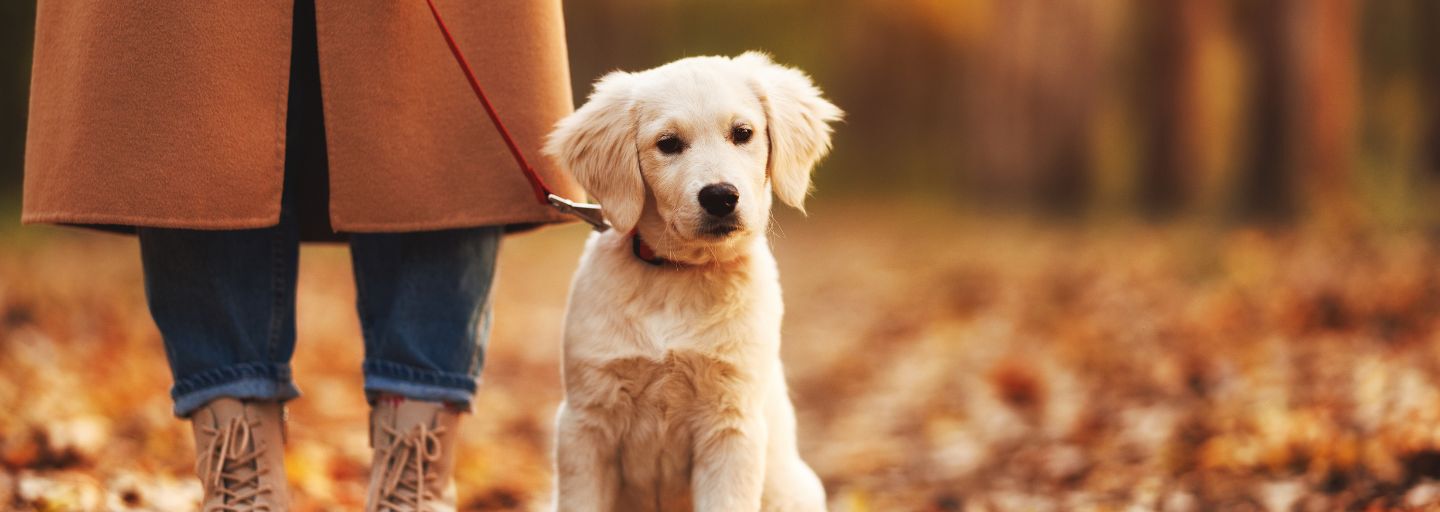Most dogs love their walks, but it can be surprising when your new puppy refuses to walk on a leash. Walking on a leash needs to be practiced, and your pup needs to learn that it can be an enjoyable time together.
Choosing a leash
There are many varieties of collars and leashes on the market. For your puppy's first leash, choose one that is lightweight, comfortable to handle, and relatively short. The clip fastening should be small and lightweight as well, as larger ones can be too heavy for puppies. Shorter leashes are important initially to effectively manage your puppy when out and about. Longer leashes can be introduced later when you and your dog are comfortable walking together and advancing your training skills.
Introducing your puppy to the lead
Dogs are sensitive to items they need to wear, so it's important to introduce collars and leashes slowly. Start by training your puppy to wear their collar around the home. Then, introduce leash training as soon as possible. Let your puppy see and sniff the leash on their own accord. If your puppy is relaxed, gently attach the lead's fastening to their collar, give them a treat, and quickly remove the lead. Repeat this several times to associate the lead with positive experiences. Make sure your puppy is exposed to the sounds of the leash clips, clicks and fastening sounds prior to training.
Next, attach the leash and walk around your home with your puppy. Start in an area where your puppy is comfortable and gradually extend to other rooms and the garden. Keep the leash loose with no tension or tugging. If your puppy is unsure of wearing a leash, attach a light ribbon for them to pull around before transitioning to a proper leash.
Once your puppy is comfortable walking around the home and garden, take them to other areas like the front yard or driveway. Gradually introduce them to the scents and noises of the neighborhood. Start with short walks and be prepared to pick up your puppy if they become overwhelmed or in a dangerous situation.
Allow your puppy to engage and explore the world while on a leash. They should have plenty of opportunities to sniff and interact with their surroundings. Using the leash as a way to control your puppy and restrict their exploration is an outdated approach. Allowing them to learn and experience their environment is essential for their development.
Always keep walks positive and end them before your puppy becomes too tired or overwhelmed. Avoid public parks and off-leash areas until your puppy is fully vaccinated and start in quieter areas and gradually progress to more exciting and busy environments.
Difficulties walking on the leash
Puppies who have difficulty walking on the leash can fall into two categories:
(i) The leash puller
Some puppies pull excessively on the leash because they are enthusiastic and energetic. Start with relaxed lessons at home and in quieter environments. You may need to drive or carry your puppy to a quieter area initially. Walk your puppy in your backyard or hallway, keeping the leash at a normal length. Teach them to connect with you when on a leash. Reward them with verbal praise and treats when they walk with a loose lead. If they start to pull, stop walking and wait until they reconnect with you. For puppies feeling overwhelmed, find quiet places to relax and take the pressure off both of you.
Once your puppy learns to connect more with you on a leash, you can start training in the streets. It may be easier to train when your puppy has expended some energy, such as on the way home from a walk or in quiet environments.
If your dog is particularly difficult to walk initially, consider using a correctly fitting walking harness that does not restrict movement or cause discomfort. Once your dog is trained to walk nicely on a leash, you can switch back to a normal collar and leash.
(ii) The puppy who refuses to walk
Some puppies refuse to walk and dig their heels in. This is not because they are being naughty or hate walking with you, but because they feel overcome and slightly terrified. Support and reassure your puppy until they feel better, and then place them back on the ground when they start to feel braver. Be kind and compassionate, as your puppy is scared of the unfamiliar outdoor world. Take things slow to desensitize them and gradually introduce them to new sights, sounds, and scents.
Continue training your puppy to accept the leash and move around with you at home. Always reward good behaviour! If your puppy shows signs of fear towards the outside world, gradually introduce them to these stimuli before going on big adventure walks.
Remember, your puppy will love their walks as much as you do in no time!
Handy tips for management around the home; You can put your puppy on a leash within your home to manage their interactions and prevent destructive or annoying behaviours. This is especially useful when you need to supervise your puppy and prevent chewing, toileting accidents, or jumping up on guests.

